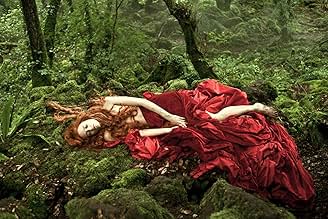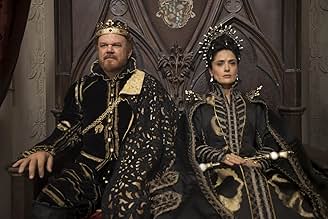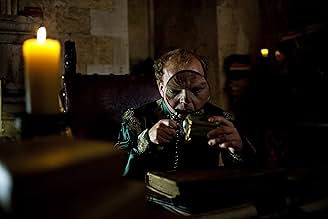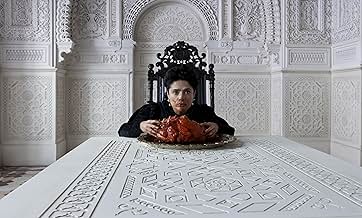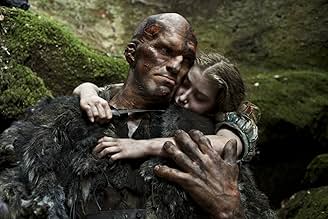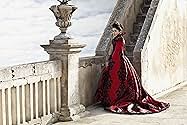Tale of Tales : Le Conte des contes
Titre original : Il racconto dei racconti - Tale of Tales
De la quête de la reine de Longtrellis jusqu'aux deux soeurs mystérieuses qui provoquèrent la passion d'un roi, en passant par le roi des Highhills obsédé par une puce géante, ces récits s'i... Tout lireDe la quête de la reine de Longtrellis jusqu'aux deux soeurs mystérieuses qui provoquèrent la passion d'un roi, en passant par le roi des Highhills obsédé par une puce géante, ces récits s'inspirent des contes de Giambattista Basile.De la quête de la reine de Longtrellis jusqu'aux deux soeurs mystérieuses qui provoquèrent la passion d'un roi, en passant par le roi des Highhills obsédé par une puce géante, ces récits s'inspirent des contes de Giambattista Basile.
- Réalisation
- Scénario
- Casting principal
- Récompenses
- 21 victoires et 15 nominations au total
Avis à la une
Greetings again from the darkness. Fairy tales have long been a fruitful source for movie material. Some, like Disney productions, land gently on the family/children end of the scale; while others like the Brothers Grimm material are much darker and adult in nature. And now, along comes director Matteo Garrone and his blending of three stories loosely based on the 17th century tales published by Giambattista Basile
and "black comedy" falls short as a description.
Mr. Garrone is best known for his chilling look at an Italian crime family in the award winning Gomorrah (2008), so a trilogy of demented monarchial fantasies may seem a bit outside his comfort zone but grab ahold of your crown jewels and be ready for just about anything.
A very strong opening leads us into the first story about a King (John C Reilly) and Queen (Salma Hayek) who are by no one's definition, the perfect couple. The Queen's inability to have children leads her to strike a deal with a Faustian seer who promises a baby to the royal couple. The only catch is that the King must kill a sea monster, and the Queen must eat its heart after it's properly prepared by a virgin. Yep, it's pretty dark and pretty odd. Of course, as with all actions, there are consequences (albino twins of different mothers) some of which are not so wonderful.
The second story involves a lecherous King (Vincent Cassel) who falls in love with a local woman based solely on her singing voice. Much deceit follows and the actions of two sisters (played by 3 actresses – Hayley Carmichael, Stacy Martin, Shirley Henderson) and some supernatural aging products lead to a twisty story of romance that can't possibly end well for anyone involved.
The third of our 3-headed story is the strangest of all, as a King (Toby Jones) nurtures a pet flea until it grows to behemoth size. Yes, a pet flea would be considered unusual, but eclipsing even that in uniqueness is the King's willingness to offer the hand of his daughter (Bebe Cave) in marriage to a frightening ogre who lives a solitary life in the mountains.
These three stories are interwoven so that we are bounced from one to another with little warning which seems only fitting given the material. Knowing the theme of the three stories does not prepare one for the details – neither the comedy, nor the dramatic turns. All actors approach the material with deadpan seriousness which adds to the feeling of a Grimm Brothers and Monty Python mash-up.
Alexandre Desplat provides the perfect score for this oddity, though the audience may be limited to those who can appreciate grotesque sequences assembled with the darkest of comedy. The moral to these stories may be difficult to quantify; however, it's a reminder that actions beget consequences no matter the time period.
Mr. Garrone is best known for his chilling look at an Italian crime family in the award winning Gomorrah (2008), so a trilogy of demented monarchial fantasies may seem a bit outside his comfort zone but grab ahold of your crown jewels and be ready for just about anything.
A very strong opening leads us into the first story about a King (John C Reilly) and Queen (Salma Hayek) who are by no one's definition, the perfect couple. The Queen's inability to have children leads her to strike a deal with a Faustian seer who promises a baby to the royal couple. The only catch is that the King must kill a sea monster, and the Queen must eat its heart after it's properly prepared by a virgin. Yep, it's pretty dark and pretty odd. Of course, as with all actions, there are consequences (albino twins of different mothers) some of which are not so wonderful.
The second story involves a lecherous King (Vincent Cassel) who falls in love with a local woman based solely on her singing voice. Much deceit follows and the actions of two sisters (played by 3 actresses – Hayley Carmichael, Stacy Martin, Shirley Henderson) and some supernatural aging products lead to a twisty story of romance that can't possibly end well for anyone involved.
The third of our 3-headed story is the strangest of all, as a King (Toby Jones) nurtures a pet flea until it grows to behemoth size. Yes, a pet flea would be considered unusual, but eclipsing even that in uniqueness is the King's willingness to offer the hand of his daughter (Bebe Cave) in marriage to a frightening ogre who lives a solitary life in the mountains.
These three stories are interwoven so that we are bounced from one to another with little warning which seems only fitting given the material. Knowing the theme of the three stories does not prepare one for the details – neither the comedy, nor the dramatic turns. All actors approach the material with deadpan seriousness which adds to the feeling of a Grimm Brothers and Monty Python mash-up.
Alexandre Desplat provides the perfect score for this oddity, though the audience may be limited to those who can appreciate grotesque sequences assembled with the darkest of comedy. The moral to these stories may be difficult to quantify; however, it's a reminder that actions beget consequences no matter the time period.
The royal court roars with laughter. A group of jesters grin and jeer at one another, do cartwheels, breathe fire. In the midst of all this mirth, the Queen sits sad and silent on her throne. Her eyes fall on one of the players and suddenly she runs off, distraught. The King chases after her, shouting that he is sorry, that he did not know. His apologies fall on deaf ears.
So begins Tale of Tales, Matteo Garrone's visually striking, but ultimately uninspiring adaptation of the Pentamerone, a book of Italian folk stories collected in the 17th century.The film cuts between three separate narrative strands, linked together by the unifying theme of all-consuming obsession. One tale centres around a monarch mad with lust, and two crones in his kingdom who desire only to be young again. Another depicts a woman who will do anything for motherhood. The third tale introduces us to a king's unhealthy fascination with a flea, and an ogre unable to set free his reluctant and unhappy bride.
Fairy tales these may be, but their delightfully disturbing content ensures that they are not meant for children. (At least by modern, if not by 17th century standards – the Pentamerone, just as full of sex and violence as Garrone's 15 rated film, was subtitled 'Entertainment for Little Ones'). Yet even though Tale of Tales is too graphic and gruesome for kids and is clearly aimed at older audiences, it remains too childishly straightforward to be captivating. I would have needed either more nuance or more mystery and suggestion for the film to draw me in and immerse me in its world. There are, for instance, scenes where characters morph into a different physical shape. Had these transformations remained unexplained by the narrative they would have evoked a sense of wonder and significance, like visual poems hinting at some elusive but compelling underlying idea. Instead, the characters transform because a magician cast a spell, and there is nothing to think about. It is the kind of simple cause and effect storytelling with a clear moral – for all three narrative strands put forward the idea that 'obsession is not good for you' – which works so well for children's stories, but is too obvious to really interest adults.
To be fair, it was never Garrone's intention to prompt intellectual engagement with Tale of Tales. 'Don't try to understand it. Just feel it, like when you are standing in front of a painting. Follow the characters, take the journey, feel the emotion,' the director said in a Guardian interview. But the characters are too one-dimensional to seem real, and I found it hard to care about their lives or fates. They also speak far too much to function well as figures onto whom one can project emotion, like when one is standing in front of a painting. It should have been show not tell, with the camera lingering on the characters' facial expressions, and allowing spectators to empathise and identify with them. Instead, feelings, from love to longing, are spoken – 'He's like a brother to me', 'I want to be young again' – and the action moves forward.
Less would have been more, with Tale of Tales. The power of the film lies in its visuals, which are beguiling, gorgeous and grotesque. The dialogues and narrative explanations serve only to trivialise the images, lessening the overall effect of the film. The trailer for Tale of Tales, a succession of visuals set to nothing but music,is better than the film itself.
So begins Tale of Tales, Matteo Garrone's visually striking, but ultimately uninspiring adaptation of the Pentamerone, a book of Italian folk stories collected in the 17th century.The film cuts between three separate narrative strands, linked together by the unifying theme of all-consuming obsession. One tale centres around a monarch mad with lust, and two crones in his kingdom who desire only to be young again. Another depicts a woman who will do anything for motherhood. The third tale introduces us to a king's unhealthy fascination with a flea, and an ogre unable to set free his reluctant and unhappy bride.
Fairy tales these may be, but their delightfully disturbing content ensures that they are not meant for children. (At least by modern, if not by 17th century standards – the Pentamerone, just as full of sex and violence as Garrone's 15 rated film, was subtitled 'Entertainment for Little Ones'). Yet even though Tale of Tales is too graphic and gruesome for kids and is clearly aimed at older audiences, it remains too childishly straightforward to be captivating. I would have needed either more nuance or more mystery and suggestion for the film to draw me in and immerse me in its world. There are, for instance, scenes where characters morph into a different physical shape. Had these transformations remained unexplained by the narrative they would have evoked a sense of wonder and significance, like visual poems hinting at some elusive but compelling underlying idea. Instead, the characters transform because a magician cast a spell, and there is nothing to think about. It is the kind of simple cause and effect storytelling with a clear moral – for all three narrative strands put forward the idea that 'obsession is not good for you' – which works so well for children's stories, but is too obvious to really interest adults.
To be fair, it was never Garrone's intention to prompt intellectual engagement with Tale of Tales. 'Don't try to understand it. Just feel it, like when you are standing in front of a painting. Follow the characters, take the journey, feel the emotion,' the director said in a Guardian interview. But the characters are too one-dimensional to seem real, and I found it hard to care about their lives or fates. They also speak far too much to function well as figures onto whom one can project emotion, like when one is standing in front of a painting. It should have been show not tell, with the camera lingering on the characters' facial expressions, and allowing spectators to empathise and identify with them. Instead, feelings, from love to longing, are spoken – 'He's like a brother to me', 'I want to be young again' – and the action moves forward.
Less would have been more, with Tale of Tales. The power of the film lies in its visuals, which are beguiling, gorgeous and grotesque. The dialogues and narrative explanations serve only to trivialise the images, lessening the overall effect of the film. The trailer for Tale of Tales, a succession of visuals set to nothing but music,is better than the film itself.
This movie is a pure piece of beauty. The direction is amazing, the photography is beyond perfection and the music is inspiring. The locations are unusual and yet are all in Italy. Of course, since the movie is an intersection three fairy tales (not for children, as they're pretty harsh), don't expect the most intriguing plot ever, but its execution has been magistral. I did not give 10 because of the screenplay, which is sometimes a little predictable, and because of the acting, which is extremely heterogeneous across actors: great Salma Hayek, Toby Jones, John Reilly and the Lees brothers, but the others a little less. All in all, I definitely recommend to see this movie.
I had the chance to see this movie. As with most, I didn't have a chance to see any trailers so I had no idea what to expect.
In a word, I would call the movie unique and not just another fairy tale movie like all the others. These have a darker twist to them and a fate and/or consequences for those involved. The movie has definite pluses and minuses.
Definite pluses: the music, the costumes, the beautiful exotic settings, the special effects, and the acting and choice of cast. All were very good.
I'm neutral on the separate plots. Some people say the plots are related and some say they aren't. I guess that's up to the viewer and how he/she interprets them. I'm not a particular fan of the macabre.
Definite minus: the movie as a whole piece of work is kind of a mess. The three stories jump around and there is no smooth time line of events. They are all kind of just thrown together. A visual mess.
Another minus: the ending. It just ends leaving you hanging and wondering what happened to certain people.
This movie is so unique that is can have such exceptional cinematography but yet have such jumbled up plot lines.
I guess the only main theme across all the stories is about obsession and how it can affect you and those around you if it is not kept under control.
In a word, I would call the movie unique and not just another fairy tale movie like all the others. These have a darker twist to them and a fate and/or consequences for those involved. The movie has definite pluses and minuses.
Definite pluses: the music, the costumes, the beautiful exotic settings, the special effects, and the acting and choice of cast. All were very good.
I'm neutral on the separate plots. Some people say the plots are related and some say they aren't. I guess that's up to the viewer and how he/she interprets them. I'm not a particular fan of the macabre.
Definite minus: the movie as a whole piece of work is kind of a mess. The three stories jump around and there is no smooth time line of events. They are all kind of just thrown together. A visual mess.
Another minus: the ending. It just ends leaving you hanging and wondering what happened to certain people.
This movie is so unique that is can have such exceptional cinematography but yet have such jumbled up plot lines.
I guess the only main theme across all the stories is about obsession and how it can affect you and those around you if it is not kept under control.
Matteo Garrone has finally strode into the international territory after the success of his last two features, GOMORRAH (2008) and REALITY (2012). TALE OF TALES debuted this year in Cannes' main competition category and is based on a collection of tales from Giambattista Basile's PENTAMERONE in the 17th century.
The film contains 3 tales, happen in 3 different kingdoms (Darkwood, Stronghold and Highmountain) with authentic locations in Italy, three grandiose castles where human frailties fester between a queen and her son, two elder sisters and a king and his daughter. Garrone doesn't shy away from the gory and chilling elements in the rather dark fairy tales, each tale encompasses its own distinctively dreadful shocker, either an underwater battle against an aquatic dragon and the ensuing devour of its heart, a bat-like monster aiming for slaughter, a blood-sucking flea growing into an abnormally giant size, a primitive ogre running amok or a flayed old hag stained in blood, for sure, they are for adults only.
The tale in Darkwood is about a queen's possession of her adolescent son, a mother's love is unconditional, but unwisely she demands the same from the young prince, however, fate binds him with an identical-looking brother (they were born at the same day under the magic of the dragon heart) and they becomes inseparable, when the queen realises her love cannot be reciprocated, she has to resort to a necromancer to settle the score once for all. Hayek stimulates a possessed urgency in her performance as the queen, again proves that she is unjustly underused in Hollywood as an exotic bombshell only.
In Stronghold, it is a tale about youth and lust, two crone sisters, one of them seduces the king with her youthful voice, but is thrown out of the window when her unsightly appearance is discovered, then being unconsciously rejuvenated by a witch's milk, she transforms into a gorgeous beauty and charms her way to be the new queen, but when her sister badgers to stay with her in the palace, her off-hand lie will lead her sister to experience the inhuman cruelty so as to achieve the same effect, only in vain, eventually her deceitful front will dissolve sooner or later. Here, Shirley Henderson upstages the rest of the line-up with her gravitating persistence and pathos-occasioning commitment as the other sister.
The Highmountain tale, a king indulges on his petty hobby, which boomerangs on the marriage of his only daughter, who is married off to an gruesome ogre under his oath, then the young princess must learn from desperation about how to retrieve her freedom using her own hands, a potent feminist manifesto, led by an engaging performance from the newcomer Cave as the princess, also Jones is pretty solid as the king, whose approachable personality makes him more human in a tall-tale.
There is no denying Garrone is further perfecting his exquisite aesthetics in constructing such a grand scale where everyone is donned with gorgeous period costumes, the surreal ingredients are brilliantly crafted too (e.g. the unwieldy underwater shooting is realistic- looking albeit it is obvious not real), and Desplat's score is as captivating as ever. But a jarring dissonance comes from the dialogue, maybe because it is all interpreted in English, or it is adapted from fairy tales written centuries ago, a sense of frustration transpires whenever the characters are hampered by their very limited lines (notably for Hayek and Henderson, both are tremendously evocative, yet all the words they can utter fail to embody that), repetitious, tedious and uninspiring. Sometimes words don't have to mean anything, but if one must use them, use them wisely, otherwise, it will be a drag on the entire film. All three tales are crisscrossed into a coherent narrative, one has no difficulty to understand the plain condemnations beneath each tale and places favourite as one feels, in short, this film is indeed a cinematic spectacle on its own terms, one should not miss.
The film contains 3 tales, happen in 3 different kingdoms (Darkwood, Stronghold and Highmountain) with authentic locations in Italy, three grandiose castles where human frailties fester between a queen and her son, two elder sisters and a king and his daughter. Garrone doesn't shy away from the gory and chilling elements in the rather dark fairy tales, each tale encompasses its own distinctively dreadful shocker, either an underwater battle against an aquatic dragon and the ensuing devour of its heart, a bat-like monster aiming for slaughter, a blood-sucking flea growing into an abnormally giant size, a primitive ogre running amok or a flayed old hag stained in blood, for sure, they are for adults only.
The tale in Darkwood is about a queen's possession of her adolescent son, a mother's love is unconditional, but unwisely she demands the same from the young prince, however, fate binds him with an identical-looking brother (they were born at the same day under the magic of the dragon heart) and they becomes inseparable, when the queen realises her love cannot be reciprocated, she has to resort to a necromancer to settle the score once for all. Hayek stimulates a possessed urgency in her performance as the queen, again proves that she is unjustly underused in Hollywood as an exotic bombshell only.
In Stronghold, it is a tale about youth and lust, two crone sisters, one of them seduces the king with her youthful voice, but is thrown out of the window when her unsightly appearance is discovered, then being unconsciously rejuvenated by a witch's milk, she transforms into a gorgeous beauty and charms her way to be the new queen, but when her sister badgers to stay with her in the palace, her off-hand lie will lead her sister to experience the inhuman cruelty so as to achieve the same effect, only in vain, eventually her deceitful front will dissolve sooner or later. Here, Shirley Henderson upstages the rest of the line-up with her gravitating persistence and pathos-occasioning commitment as the other sister.
The Highmountain tale, a king indulges on his petty hobby, which boomerangs on the marriage of his only daughter, who is married off to an gruesome ogre under his oath, then the young princess must learn from desperation about how to retrieve her freedom using her own hands, a potent feminist manifesto, led by an engaging performance from the newcomer Cave as the princess, also Jones is pretty solid as the king, whose approachable personality makes him more human in a tall-tale.
There is no denying Garrone is further perfecting his exquisite aesthetics in constructing such a grand scale where everyone is donned with gorgeous period costumes, the surreal ingredients are brilliantly crafted too (e.g. the unwieldy underwater shooting is realistic- looking albeit it is obvious not real), and Desplat's score is as captivating as ever. But a jarring dissonance comes from the dialogue, maybe because it is all interpreted in English, or it is adapted from fairy tales written centuries ago, a sense of frustration transpires whenever the characters are hampered by their very limited lines (notably for Hayek and Henderson, both are tremendously evocative, yet all the words they can utter fail to embody that), repetitious, tedious and uninspiring. Sometimes words don't have to mean anything, but if one must use them, use them wisely, otherwise, it will be a drag on the entire film. All three tales are crisscrossed into a coherent narrative, one has no difficulty to understand the plain condemnations beneath each tale and places favourite as one feels, in short, this film is indeed a cinematic spectacle on its own terms, one should not miss.
Le saviez-vous
- AnecdotesThe movie was based on the Pentamerone ("The Tale of Tales, or Entertainment for Little Ones"), a collection of fairy tales by 17th century Italian poet and courtier Giambattista Basile.
- GaffesIn the credits the name of the Italian composer Girolamo Frescobaldi (1584-1643) is misspelled 'Frescobladi'.
- Crédits fousDedication before end credits: "To Nico and Marco"
- ConnexionsFeatured in Medieval Weapons Master Rates 11 Weapons and Armor n Movies and TV (2020)
- Bandes originalesSe l'aura spira tutta vezzosa, F 7.15
Composed by Girolamo Frescobaldi
Meilleurs choix
Connectez-vous pour évaluer et suivre la liste de favoris afin de recevoir des recommandations personnalisées
- How long is Tale of Tales?Alimenté par Alexa
Détails
- Date de sortie
- Pays d’origine
- Sites officiels
- Langues
- Aussi connu sous le nom de
- Tale of Tales
- Lieux de tournage
- Castel del Monte, Andria, Bari, Apulia, Italie(Highhills castle)
- Sociétés de production
- Voir plus de crédits d'entreprise sur IMDbPro
Box-office
- Budget
- 12 000 000 € (estimé)
- Montant brut aux États-Unis et au Canada
- 118 925 $US
- Week-end de sortie aux États-Unis et au Canada
- 8 871 $US
- 24 avr. 2016
- Montant brut mondial
- 5 500 277 $US
- Durée2 heures 14 minutes
- Couleur
- Mixage
- Rapport de forme
- 2.35 : 1
Contribuer à cette page
Suggérer une modification ou ajouter du contenu manquant

Lacune principale
By what name was Tale of Tales : Le Conte des contes (2015) officially released in Canada in French?
Répondre






